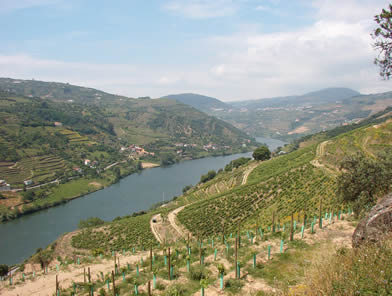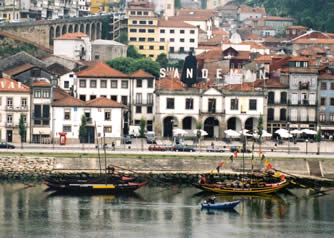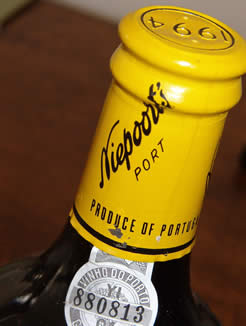|

Introducing
Port
wines
In
a class of its own, Port is a unique fortified wine style hailing from
the spectacular terraced vineyards of
Portugal’s Douro
Valley (pictured above). It has inspired imitations from many of the world’s wine regions,
but much as with Champagne, none of the competitors can match a top vintage Port from a good
producer. Want to know more about Port wines? Then read on.
Port
is a brilliant, unique wine style that derives its flavour, strength
and sweetness from the process of adding spirit to still-sweet
part-fermented grape must. Actually, it would probably be more
accurate to say that Port represents two rather different wine styles,
depending whether the wine is primarily aged in bottle or in cask.
Most readers will probably be familiar with the sweet, dark, tannic,
richly fruited style of Vintage and
Single
Quinta
Ports
which are bottled fairly young, and will then slowly age to
mellowness. Less commonly appreciated are the cask-matured Ports known
as Tawny or Colheita (these are vintage dated tawnies), which are
typically lighter in colour, with soft, spicy nutty flavours and less
overt fruitiness. Both styles are worthwhile.
White
Ports do exist, and while most aren’t up to much, there are some
good ones. But here we’re going to concentrate on the predominant
form of Port, which is made from red grapes.
Port’s
history
History
can get a bit boring, so I’ll keep this brief. It’s hard to
dissociate Port from the history of the region that produces it, the
Douro. Vines have been grown in the
Douro
since as far back as Roman times, but this was a poor region, and
grapes were grown as part of a polyculture: the horizontal areas of
the terraces were reserved for food crops, while vines were planted in
the gaps of the terrace walls. Typical old-style terraces are
pictured below.
 Port
itself didn’t exist until the late 17th century, and this is largely
the fault of us Brits. The English and Portuguese developed a special
trading relationship that flourished off and on for a number of
centuries. The Douro’s big break came when war broke out between
France
and England
in 1689, which forced the English to tap new, non-French sources of
wine. This led to an increased demand for the newly discovered Port
wine. In those days doctoring wine was commonplace, and it was found
that the addition of brandy had a twofold benefit: it made the wine
more stable, helping it survive the voyage to England
without harm, and because the brandy was added before fermentation was
completed, it made the wine sweeter. The English developed quite a
taste for it. Remember, it’s much easier to make drinkable Port than
it is drinkable table wine. Port
itself didn’t exist until the late 17th century, and this is largely
the fault of us Brits. The English and Portuguese developed a special
trading relationship that flourished off and on for a number of
centuries. The Douro’s big break came when war broke out between
France
and England
in 1689, which forced the English to tap new, non-French sources of
wine. This led to an increased demand for the newly discovered Port
wine. In those days doctoring wine was commonplace, and it was found
that the addition of brandy had a twofold benefit: it made the wine
more stable, helping it survive the voyage to England
without harm, and because the brandy was added before fermentation was
completed, it made the wine sweeter. The English developed quite a
taste for it. Remember, it’s much easier to make drinkable Port than
it is drinkable table wine.
The
strong demand for Port led to overproduction and the fraudulent making
and labelling of wines, which in turn led to a price collapse in the
mid-18th century. To remedy this, the ruthless Marques de Pombal
instituted the first world’s first system of origin control and
regional classification in 1757, coupled with a blitz on neighbouring
regions such as Bairrada which had been supplying faux Port. In the Douro, wines from good cultivation sites (vinho de feitoria) were approved
for export, while wines from inferior cultivation sites stayed at
home. From this time the Douro
wine regulators developed a fondness for rules which has stayed with
them to this day.
The
19th century saw increasing development of viticulture in the Douro, with many independent estates (Quintas) making their own wine. Then,
along with most of the world’s winegrowing regions, the Douro
was hit by the twin plagues of oidium and phylloxera in the second
half of the 19th century. This destroyed the livelihoods of many
winegrowers, but their misfortune was an opportunity for others, and
larger vineyards emerged owned by a handful of producers who purchased
the run-down Quintas on the cheap. Got a couple of Douro
quintas going at a good price. They’ve got your name written on
them. Nice one my son.
 This
led to a change in the way
Port
was made and marketed. Power shifted to the hands of shippers, who
established themselves in
Vila Nova de Gaia (pictured left), over the river from
Porto. The shippers developed their own house brands which they matured and
marketed from Vila Nova, separating this process from the production
in the Douro. This situation progressed to the point where it became law that all
port wine exports had to take place from Vila Nova. This protectionist
sort of rule consolidated power in the hands of a few. In 1852 Port
production was carried out by some 79 Quintas in the Douro. By 1954 it had shifted to 81 Port lodges in Vila Nova. Then, by 1990
this number had reduced to just 27. This
led to a change in the way
Port
was made and marketed. Power shifted to the hands of shippers, who
established themselves in
Vila Nova de Gaia (pictured left), over the river from
Porto. The shippers developed their own house brands which they matured and
marketed from Vila Nova, separating this process from the production
in the Douro. This situation progressed to the point where it became law that all
port wine exports had to take place from Vila Nova. This protectionist
sort of rule consolidated power in the hands of a few. In 1852 Port
production was carried out by some 79 Quintas in the Douro. By 1954 it had shifted to 81 Port lodges in Vila Nova. Then, by 1990
this number had reduced to just 27.
Things
changed in 1986 when Portugal
joined the EU. Producers in the Douro
were allowed to export their products independently, albeit with some
limiting conditions: vineyards must have at least 150 000 bottles and
sales inventory for three years in store. These conditions apply only
to Port, and not table wine, but despite their presence the last
couple of decades have seen the emergence of a number of new Quintas,
such as Infantado, Crasto, Vallado and Vale Dona Maria, who make their
own Ports without a presence in Vila Nova.
Port
styles
Vintage
The pinnacle of Port production. On average just four times a
decade a vintage is good enough to be ‘declared’ by the major Port
houses. They then blend and bottle just the very best of their wines
after two years in cask. These wines are intense, sweet, ripe and very
tannic in their youth. They develop for many decades in the bottle and
start hitting their prime after about 20 years. Justifiably expensive,
these wines throw a thick sediment and need to be decanted. The art of
making good vintage Port is one of selecting and blending, and
traditionally Port houses have relied on expert blenders to bring
together the various component wines to make a Port that is balanced,
harmonious and ageworthy. Just a small fraction of all Port produced
finds its way into the Vintage wines. You won’t see many Vintage
ports at your local supermarket, but good independent merchants should
have a selection. Interestingly, mature vintage Ports that are ready
for drinking (vintages in the 1970s and 80s) are often available
cheaper than the more recent vintages, which aren’t yet ready to
drink. Recent good vintages include 2000, 1997 and 1994. Expect to pay
around £40 a bottle.
Single
Quinta
Whereas Vintage Ports are blended with great skill from different
vineyard sources, Single Quinta Ports are, as the name suggests, made
from single estates. This is where some of the best value Port is to
be found. Essentially, they are treated the same as Vintage Port,
bottled just two years after harvest, and will also need decanting. In
many cases these wines are components of Vintage Ports during vintage
years and are then released as Single Quinta wines in non-Vintage
years. They might also be from independent estates who bottle their
own Ports each year, an increasingly common practice. You’ll find
Single Quinta wines in supermarkets and high street wine shops, as
well as independent merchants. £20 will secure you a good one.
Late
Bottled Vintage (LBV)
These are vintage-style wines bottled after five or six years in
cask. From good houses they can be nice wines, but frequently they are
uninspiring. Choose carefully. ‘Traditional’ LBVs are worth
looking out for: these are bottled earlier, unfiltered, and will throw
a sediment: you get some of the character of real vintage Port at a
fraction of the price. While you can get an LBV for around £6, it’s
probably better to pay £10 and stick to the well known names such as
Taylors, Grahams or Dows. My favourites are those by the smaller
producers Niepoort, Crasto and Infantado; the Quinta do Noval LBV is
also very good.
Tawny
 Tawnies are wood matured Ports that derive much of their flavour
from extended ageing in cask. Good ones will be designated as 10-, 20-
30- or even 40-year old, and often offer lovely nutty, spicy
complexity and balance. Many commentators argue that the 30- and
40-year old tawnies aren’t worth the premium they command. I’ve
tasted excellent wines in both the 10- and 20-year old brackets. Tawnies are wood matured Ports that derive much of their flavour
from extended ageing in cask. Good ones will be designated as 10-, 20-
30- or even 40-year old, and often offer lovely nutty, spicy
complexity and balance. Many commentators argue that the 30- and
40-year old tawnies aren’t worth the premium they command. I’ve
tasted excellent wines in both the 10- and 20-year old brackets.
Colheita
These are vintage-dated tawnies. They’re usually worthwhile, and
sometimes brilliant. Colheitas are a bit of a rarity in the UK
market, but they’re worth looking out for. They generally don’t
improve much in the bottle, so you aren’t meant to put them away for
decades, as with Vintage Ports.
‘Vintage
Character’ and ‘Ruby’
Bargain basement wines that are best avoided. The same goes fro
cheap ‘Tawnies’ that are actually a blend of red and white Ports.
Nasty. They are fantastically cheap, but it really isn’t right to
expect to get a bottle of Port for £5.
Port
seems to have settled into a three-year cycle. With declarations in
1994, 1997 and 2000 it looks like the hot 2003 growing season might
have produced the next widespread vintage declaration. 2004 is also
looking good, but the Port houses prefer not to declare back-to-back
vintages. The good news for the Port trade is that the demand for
Vintage and Single Quinta wines is currently stronger than ever. The
bad news is that shippers are having problems with their lesser wines,
which tend to sell on price rather than on the intrinsic quality of
what is in the bottle. Still, at LBV level and above, quality is
better than ever these days, which is good news for consumers.
Vintage
Port
is still fairly priced compared with other great wines, although the
recent surge of interest in Port across the
Atlantic
has pushed the prices of recent releases up a bit. As a consequence,
shrewd consumers might want to consider buying mature vintages for
current drinking. Typically, it is possible to pick up older Ports
that are ready to drink for less than the cost of current releases,
and the added benefit is you won’t have to wait 20 years to enjoy
them.
Leading
Port
houses and Quintas
-
Taylor’s
-
Graham
-
Quinta
do Noval
-
Fonseca
-
Niepoort
-
Dow’s
-
Warre’s
-
Churchill
-
Quinta
de Roriz
-
Quinta
do Vesuvio
-
Quinta
do Infantado
-
Smith
Woodhouse
-
Quinta
do Malvedos
-
Quinta
do Bomfin
-
Quinta
de Vargellas
-
Quinta
do Crasto
-
Quinta
de la Rosa
-
Quinta
da Cavadinha
Vintage
guide
2003
It was an unusually hot summer, even for the Douro. While this created problems for some growers, it looks like 2003
will be a generally successful vintage with some superb, concentrated
wines being made. A potential vintage declaration?
2002
Pretty disastrous with almost constant rain through the harvest.
2001
A good, but not exceptional year for Port, with some very good single
Quinta wines.
2000
A brilliant vintage with some stunning, concentrated, well balanced
Ports. A universal declaration.
1999
Was looking good until the rains arrived. Good Ports here and there,
but proceed carefully.
1998
Unsettled harvest weather spoiled what would otherwise have been a
great year. Some good single Quinta wines.
1997
A very good but not great year, and a universal declaration: the first
since 1994. The 1997 Ports frequently lack the balance of the 2000s
and the richness of the 1994s.
Other
good vintages: 1994, 1992, 1991, 1985, 1983, 1980, 1977.
see
also: tasting notes of Portuguese wines; Table
wines from the Douro; Photographs from
the Douro
Back to top
|

